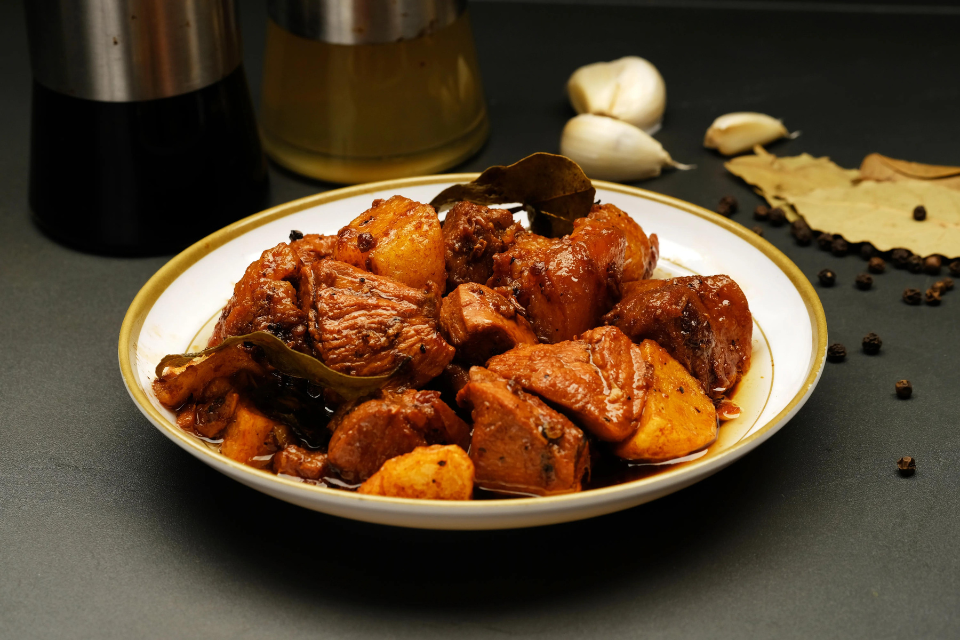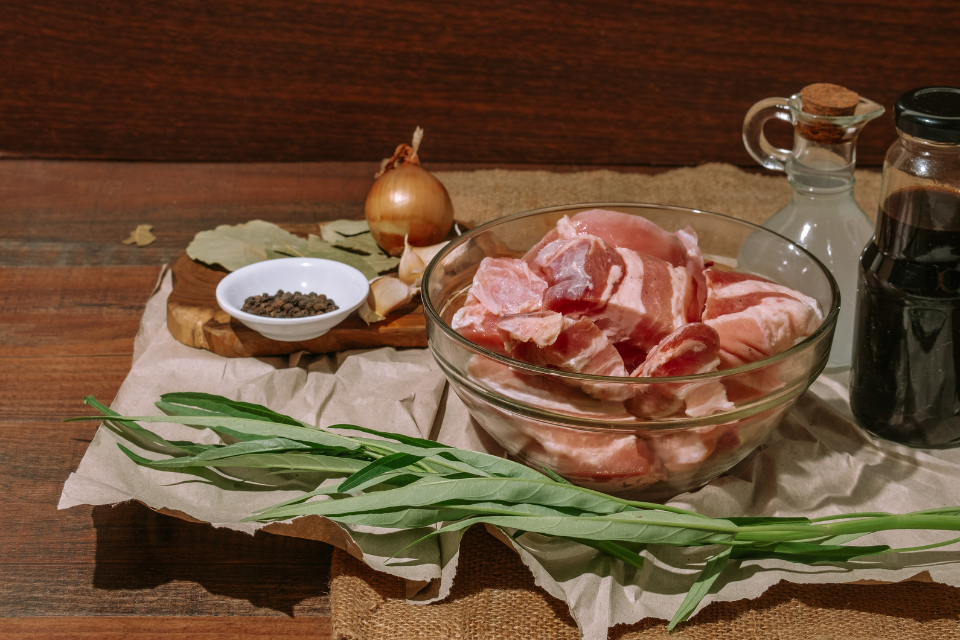The Best Fluffy Pancakes recipe you will fall in love with. Full of tips and tricks to help you make the best pancakes.

Philippine Adobo stands as the quintessential dish of the Philippines, revered as a comforting staple in both Filipino households and abroad. This culinary gem is crafted with a delectable blend of Wheat-Free Tamari, coconut vinegar, garlic, and a medley of mild Filipino spices, presenting an irresistible fusion of umami, salty, and tangy flavors.
A topic of spirited discussion among Filipino families both within the nation and in the United States revolves around the ideal choice of protein for Adobo. Opinions vary widely, with some advocating for chicken, pork, fish, or even tofu as the primary ingredient.
Regardless of the protein selected, it is gently simmered in vinegar, transforming it into a pungent, sweet, sour, and salty dish. Through the cooking process, the vinegar’s sharpness is mellowed, allowing it to blend harmoniously with the meat’s natural flavors. Invariably, the edges of this culinary masterpiece are seared until crisp, and the sauce is poured over it. Through a meticulous cooking process, Adobo achieves the perfect balance between its taste profiles.
How Does Filipino Adobo Taste?
Adobo is not just a dish but a culinary technique hailing from the Philippines. It involves the slow simmering of meat or seafood in a rich marinade of vinegar, soy sauce, and garlic. This method yields a dish that’s delightfully tangy and savory, with the flavor profile subtly shifting based on the chosen protein. For this particular preparation, I opted for pork adobo, a choice that was unanimously celebrated for its exquisite blend of tastes.
Adobo shared here is more traditional, omitting coconut milk, a modern twist typically found in other variations such as our chicken adobo. This recipe embraces the natural richness of pork shoulder, while coconut milk can soften the sharpness of the sauce. With its inherent fattiness, the dish is perfectly balanced by the vinegar’s tang.
Making Pork Adobo, a Filipino favorite!
Ingredients:
- 600g thick pork belly
- ½ cup soy sauce
- ½ cup vinegar
- Brown sugar, 1 tbsp
- 20 cloves of garlic
- 1 slice of ginger
- 1 tbsp whole black peppercorns
- 5 bay leaves
- 1 tablespoon neutral oil
- For serving, jasmine rice
Directions:
- Cut the pork belly into sizeable chunks, approximately 4cm width and 3cm thickness, adjusting to your preference to reduce cooking time if desired.
- Heat a large Dutch oven or skillet over high heat. Drizzle neutral oil and sear the pork belly until lightly golden brown on each side.
- Remove the pork belly and reduce the heat to medium-low.
- Add garlic, ginger, and black peppercorns to the pot. The garlic should turn pale golden when it is stirred until aromatic.
- Brown sugar, vinegar, and soy sauce should be added together. Bring to a simmer.
- Add the bay leaves to the pot with the pork belly. If the mixture stops simmering, increase the heat to high briefly, then reduce to a rolling simmer.
- Prepare a cartouche by cutting a hole in the middle of a piece of parchment paper and placing it on top of the liquid to control evaporation and ensure the pork belly remains submerged and tender. Alternatively, leave the lid slightly ajar.
- Simmer on low heat for 1 hour, or bake in a preheated oven at 325°F/165°C for 1 hour and 30 minutes. Alternatively, pressure cook without water for 15 minutes on high pressure, followed by a 5-minute rest before releasing steam.
- Jasmine rice is the perfect accompaniment to pork adobo.
Regional Twists in Filipino Adobo
There are many regional variations of Filipino Adobo, each adding a unique flavor to this beloved culinary gem. The Visayas region, particularly Negros and Panay, transforms Adobo into “Adobo sa Gata” or coconut milk adobo by adding coconut milk. As a perfect complement to the tangy vinegar and savory soy sauce, this rendition offers a velvety texture and a subtle sweetness.
Meanwhile, in the Bicol region of southeastern Luzon island, Adobo is fiery. “Adobo sa Lada,” or chili adobo, is infused with bold and vibrant heat from chili peppers, grown on the region’s abundant farms. With this spicy variation, the traditional flavors are given an exhilarating kick, appealing to fans of fiery cuisine.
Local ingredients, cultural practices, and personal preferences influence countless variations of Adobo throughout the Philippines. Depending on the region, pineapple, potatoes, or seafood may be included, demonstrating the dish’s versatility and adaptability. Its tangy, savory, and aromatic flavors continue to captivate palates around the globe, regardless of these regional nuances.
The health benefits of lean meat adobo
Adobo is a wholesome addition to any diet when prepared with lean meats such as chicken or fish. As a result, Adobo is a satisfying and nutritious meal choice, as these lean protein sources contribute to muscle development and repair. As well as enhancing the flavor profile, garlic, ginger, and various spices contribute to the health benefits of the dish. The antibacterial properties of garlic and the antiviral properties of ginger, for instance, are well known. Black peppercorns, for example, contain antioxidants that help reduce oxidative stress and promote overall health. In general, Adobo can support a balanced and wholesome lifestyle when it is made with lean meats and wholesome ingredients.

Conclusion
In short, Filipino Adobo represents the diversity of our culture and culinary flair. Its countless variations, such as “Adobo sa Gata” or “Adobo sa Lada,” bring people from all over the world together.
But Adobo isn’t just delicious—it’s packed with goodness too. Made with lean meats and wholesome ingredients, it’s a powerhouse of protein and health-boosting spices like garlic and ginger.
Let us celebrate the rich tapestry of Filipino culture as we enjoy the mouthwatering aroma of Adobo. A simple meal like Adobo reminds us of the simple pleasures of life, whether we’re in the kitchen or with family. Let’s toast to the enduring legacy of Adobo and the vibrant flavors that make us proud to be Filipinos!
FAQ.
Q. What makes Filipino Adobo unique?
Filipino Adobo is a tantalizing blend of wheat-free Tamari, coconut vinegar, garlic, and mild Filipino spices. Filipino cuisine has a unique blend of umami, salty, and tangy notes.
Q. Why is there a debate about the ideal protein for Adobo?
Filipino families debate the choice of protein for Adobo due to regional differences and personal preferences. It can be made with chicken, pork, fish, or even tofu, each adding its own unique flavor.
Q. What are the health benefits of lean meat Adobo?
The health benefits of lean meat Adobo are numerous. Garlic, ginger, and spices provide antibacterial, antiviral, and antioxidant properties. When prepared with wholesome ingredients, lean meat Adobo can boost overall health.





